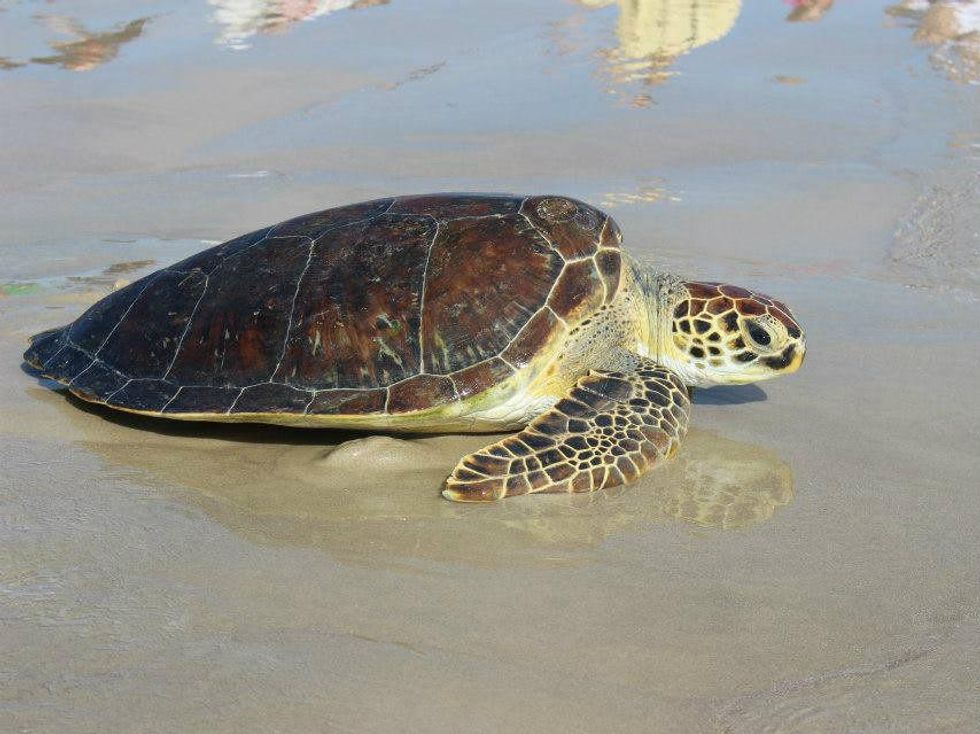Austin's Environmental Year
10 major Austin environmental actions of 2013
Austin is known for loving its natural environment, and sometimes we take action to protect and enhance it. Here, in no particular order, are 10 things that happened in 2013 that will have a positive effect on our outdoors for years to come.
Bags banned
The city's ban on single-use bags may have kept as many as 26 million plastic bags out of the landscape and landfill, based on typical annual consumption. One high-quality reusable bag can replace 600 disposable ones over its lifetime. In the Ocean Conservancy’s 2013 Coastal Cleanup, plastic bags were the fourth most common item collected, with 1,019,902 bags picked off of beaches.
Trail trees planted
More than 100 trees were planted by volunteers along the Lady Bird Lake hike and bike trail; they include Mexican olive, Anacacho orchid, flameleaf sumac, kidneywood, goldenball leadtree, Texas mountain laurel, Mexican buckeye and evergreen sumac trees.
One high-quality reusable bag can replace 600 disposable ones over its lifetime.
Habitat created
More than 32 Austin residential yards were certified as wildlife-friendly under the city’s 2013 Neighborhood Habitat Challenge. A program of the National Wildlife Federation, certified habitats must provide food, water, cover and a place for wildlife to raise their young, whether on an apartment balcony or an acre backyard. As more habitat is lost and what is left becomes fragmented, these small oases become critical to the survival of wildlife. So far, more than 150,000 sites nationwide have received certification.
Invasive plants identified
The city trained 150 volunteers on invasive plant species identification and monitoring. These volunteers will work with city staff to develop a base map of invasive plant species on city property. Invasive plants such as hydrilla and arundo donax (giant cane) can reduce native biodiversity; interfere with valuable ecosystem functions; reduce the value of streams, lakes and reservoirs for recreation, wildlife and public water supply and reduce the recreational value of natural areas and parks. (Note to city: can we stop mapping invasive plants and start removing them now?)
Sustainable developments certified
The University of Texas’ Lady Bird Johnson Wildflower Center’s Sustainable Sites (SITES) program announced three new certifications, bringing the total to 26 across the country since 2010. A comprehensive rating system for sustainable landscapes, SITES is a collaboration of the Wildflower Center with the American Society of Landscape Architects (ASLA) and the United States Botanic Garden. It provides development guidelines and recognition of sustainable landscapes — projects with or without buildings — based on their planning, design, construction and intended maintenance. The newly certified projects are Shoemaker Green, a university green space in Philadelphia; Washington Canal Park in Washington, DC, and Phipps’ Center for Sustainable Landscapes in Pittsburgh, which is the first SITES pilot project to have received the maximum four stars.
Lawns greened
Habiturf, a mixture of low-maintenance native grasses developed by a University of Texas at Austin ecologist, should be available as sod in spring 2014. The university gave a 10-year, nonexclusive license for Habiturf to Bladerunner Farms of Poteet, Texas. Mark Simmons, director of the Wildflower Center’s Ecosystem Design Group, notes that commercial and private lawns in the United States currently use more water, fertilizers and chemicals than any single agricultural crop. Habiturf is made of a combination of grasses that occur naturally in Texas and Midwestern states where prairies once were common. Research showed that it produces a uniform carpet of lawn that stays 20 percent thicker into the summer than bermuda grass and develops half as many dandelions as bermuda grass and buffalo grass, which means it should require less herbicide use.
Note to city: can we stop mapping invasive plants and start removing them now?
Burned pines replaced
More than 68,000 loblolly pine and mixed hardwood trees were planted in fire-ravaged Bastrop by the Bastrop County Community Reforestation Program, which includes TreeFolks, Bastrop County and their Sheriff’s Office, Bowman Consulting, American YouthWorks Texas Conservation Corps, the Apache Foundation, the Arbor Day Foundation, the Lost Pines Recovery Team, HEB and McCoy’s Building Supply. Next year, the goal is to plant 750,000 trees.
Springs protected
San Marcos and Comal springs are more likely to still be around for your kids to enjoy, thanks to approval of The Edwards Aquifer Habitat Conservation Plan by the US Fish and Wildlife Service. The plan, which took five years of work gaining consensus among more than 39 stakeholder groups, is designed to protect threatened or endangered species whose only known habitats are the aquifer-fed Comal and San Marcos springs. Protecting those species means maintaining adequate flow in the springs, which also means swimmers and tubers can continue to enjoy the waters along with residents of habitats downstream.
Water for whooping cranes — maybe
U.S. District Judge Janis Graham Jack ruled that the Texas Commission on Environmental Quality was responsible for the death of 23 endangered whooping cranes and that authorities must come up with a plan that assures that cranes will have adequate supplies of fresh water. Protecting the cranes involves keeping adequate water in the Guadalupe and San Antonio rivers, whose watersheds abut Austin and around which many Austinites recreate.
Protecting whooping cranes involves keeping adequate water in the Guadalupe and San Antonio rivers, whose watersheds abut Austin and around which many Austinites recreate.
A bit of backstory. Whooping cranes became one of the first species to be listed under the federal Endangered Species Act (ESA) in 1967, when only about 40 birds remained. Today, a population of about 300 nests in Canada and migrates to Aransas National Wildlife Refuge on the Texas coast for winter. In March 2010, the nonprofit Aransas Project sued the TCEQ, alleging that the state agency violated the ESA by authorizing withdrawals of water from the Guadalupe and San Antonio rivers that resulted in too little freshwater flowing into the coastal estuaries where the birds live. That, the suit alleged, increased water salinity and killed blue crabs on which the cranes dine, thus causing the death of 23 cranes.
The lawsuit went to trial December 2011, various political shenanigans ensued (this is Texas, and we’re talking about water) and the judge had yet to make a ruling, so in October 2012, Texas officials asked that the judge reopen the case. In March 2013, the judge ruled for the cranes. Texas Attorney General Greg Abbott requested a stay of the verdict, which was granted by United States Court of Appeals for the Fifth Circuit. The appeals court heard arguments in August but has yet to take action. Fortunately for the waiting whoopers, a lot of rain fell in the watershed this fall.
Sea turtles saved
This year, Seafood Watch placed Louisiana shrimp that are caught without Turtle Excluder Devices on its “Avoid” list. Here’s why. Federal regulations require shrimp trawlers to use TEDs, trap doors that allow air-breathing sea turtles to swim out of trawl nets so they won’t drown. Use of these devices has reduced sea turtle deaths throughout the Gulf of Mexico, but a Louisiana state law forbids officials from enforcing TED requirements in its state waters.
Seafood Watch, a program of the Monterey Bay Aquarium, released an assessment of the US shrimp fishery in the Gulf of Mexico and South Atlantic in October that concluded that most wild-caught U.S. shrimp remains a good alternative — except for shrimp from Louisiana. Plenty of Austin restaurants and markets sell shrimp — make sure you know where the ones you buy originated.





 Say goodbye to 2025 and hello to 2026. austintexas.org
Say goodbye to 2025 and hello to 2026. austintexas.org